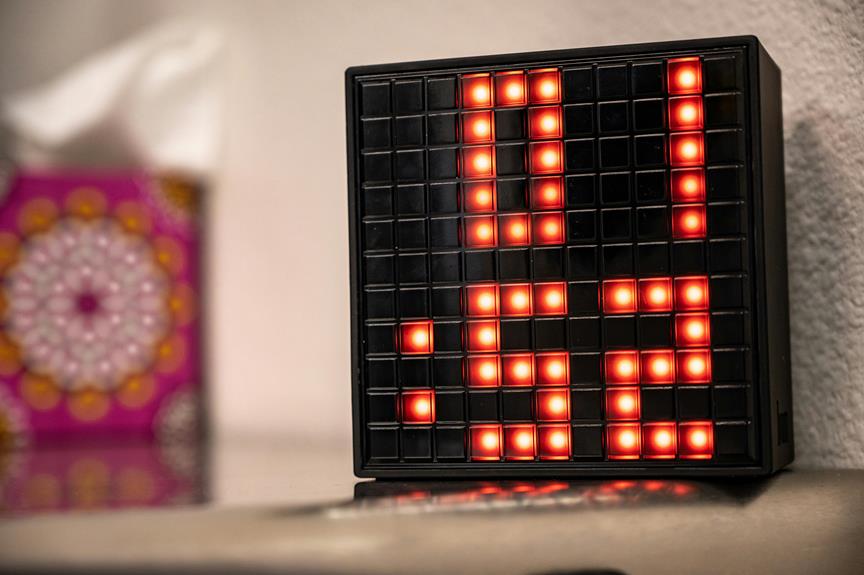When you first unbox your AeroGarden Harvest Elite, you'll notice its sleek interface which includes a helpful control panel for setting the light timer—a vital step for ensuring your herbs and vegetables receive the best amount of light. You'll start by pressing the 'Lights' button, then adjust the timing using the '+/-' keys to fit your daily schedule. This might seem straightforward, but there's a common pitfall: not aligning the light cycle with your plant's specific needs, which can drastically affect their growth. What happens if you get this wrong, and how can you avoid it? Let's unpack this further.
Key Takeaways
- Identify your AeroGarden model to determine the specific light timer settings available.
- Locate the control panel, typically at the base or front of the unit.
- Navigate to 'Set Lights Timer' on the control panel to adjust start and stop times.
- Use the plus and minus keys to set the desired light duration for your plants.
- Save your settings by pressing and holding the 'Save' or 'Enter' button to ensure consistency.
Understanding Your AeroGarden Model
Prior to setting your light timer, it's important to identify which AeroGarden model you own. Each model has unique features and settings that impact how you'll manage your garden's lighting needs. You've got options ranging from the small, beginner-friendly Sprout to the larger, feature-rich Bounty models. Knowing your specific model allows you to tailor your approach, ensuring your plants receive the best amount of light without wasting energy.
If you're unsure about your model, check your purchase documents or look for a label on your unit. This detail is essential because light settings can vary significantly between models. For instance, higher-end models like the Bounty Elite offer fully customizable light options, while simpler ones like the Sprout have more basic presets.
You're in control here, and understanding your AeroGarden's capabilities lets you maximize growth and efficiency. Think about what you're growing—herbs, flowers, vegetables—and how light affects their development. Your AeroGarden model is designed to give you a leg up, but it's your job to use that advantage effectively.
Start by identifying your model, and then move forward with precision, setting up your garden for success.
Locating the Control Panel
Once you've identified your AeroGarden model, you'll need to find its control panel to adjust the light settings. This is your command center, where you can tailor your garden's environment to your specific needs. For most models, the control panel is prominently located at the base or on the front of the unit. It's designed to be accessible and user-friendly.
Start by examining the base of your AeroGarden. If you're using newer models like the Bounty or the Harvest, you'll find a sleek, interactive LCD touchscreen that eagerly awaits your inputs. This panel not only allows you to adjust the lights but also to monitor water levels, nutrient schedules, and more, putting you firmly in control of the growing process.
For older models, such as the Classic 6, the panel might be more basic with push buttons and small LED indicators. Even with these simpler systems, the controls are intuitive, ensuring you won't waste time guessing how to make the necessary adjustments.
Initial Light Timer Setup
To establish your AeroGarden's light timer, first make sure the unit is powered on and the control panel is active. Then, find the "Lights" button, typically located on the front panel. Pressing this will bring you into the light settings mode. Here's where you'll set the initial timing for your garden lights, ensuring they turn on and off at the best times to promote plant growth without your constant intervention.
Here's a simple table to guide you through the initial settings you might encounter:
| Function | Description |
|---|---|
| Set Clock | Adjust the current time on your AeroGarden. |
| Set Lights Timer | Enter the mode to set the start and stop times for your lights. |
| Confirm | Save the settings by confirming your choices. |
| Exit | Leave the settings menu. |
After setting the clock, navigate to the 'Set Lights Timer' option. You'll use the plus and minus keys to select the appropriate start and stop times for the lights. Remember, setting these times initially doesn't require adjustment of the duration—that's a separate step. Confirm your settings and then exit the menu to save. You've now taken a big step towards automated plant care!
Adjusting Light Duration
After setting the initial light timer, you'll need to adjust the light duration to match your plants' specific needs. Different plants thrive under varying amounts of light, and it's important you tailor the settings to foster ideal growth.
Start by determining the ideal light duration for your specific plants. Most herbs and lettuces require about 14 to 17 hours of light per day, while flowering plants like tomatoes and peppers might need upwards of 16 to 18 hours.
Once you have this information, you're ready to make adjustments directly on your AeroGarden. Navigate to the control panel of your AeroGarden unit. Here, you'll find options to increase or decrease the light duration. It's a straightforward process: simply select the 'Light Settings' menu and adjust the hours using the + or – buttons.
You're in complete control here, so tweak it as needed based on your observations and the plants' responses. Monitor your plants after making these adjustments. If they appear stressed or aren't growing as expected, further fine-tuning may be necessary.
Saving Your Light Settings
Make sure you save your adjusted light settings to maintain consistency for your plants. Once you've found the ideal light duration that suits your garden's needs, it's important to lock in those settings. This will guarantee that your plants receive a steady amount of light, even if there's a power outage or if the unit is unplugged.
To save your settings, navigate to the control panel on your AeroGarden. After adjusting the light duration, press and hold the 'Save' or 'Enter' button until you hear a confirmation beep or see a flashing light, which indicates that your settings have been successfully saved. This step is essential as it prevents any accidental changes and keeps your light cycle consistent, which is key to plant health and growth.
Don't skip this step, thinking you'll just adjust it daily. It's not only inefficient but also increases the risk of human error, affecting your plants' growth cycle. By saving your settings, you're taking control and ensuring that your plants thrive under ideal conditions, without the need for daily recalibration.
Trust the process, set it, save it, and let your garden flourish with minimal fuss.
Troubleshooting Common Issues
Despite your best efforts, you might encounter some common issues with your AeroGarden's light settings. Don't worry, you're in control, and most problems have straightforward fixes. Here's a quick guide to identifying and resolving these issues effectively:
| Problem | Solution |
|---|---|
| Light won't turn on | Check the power supply and make sure the unit is plugged in correctly. |
| Timer not keeping time | Reset the timer. Unplug your AeroGarden for a minute, then plug it back in. |
| Light turns off unexpectedly | Ensure the timer is set correctly; refer to the manual to reset if necessary. |
| Light too dim | Check if the LED lights need replacement or if there's an issue with the settings. |
If the light still won't operate properly after you've tried these steps, it might be a sign of a deeper electrical issue. In such cases, it's best to contact AeroGarden customer support for professional assistance. Remember, you're equipped to handle these minor setbacks, and a little troubleshooting can go a long way in maintaining the best function of your AeroGarden's lighting system.
Tips for Optimal Lighting
To maximize your AeroGarden's growth, make sure the light timer is set for 16-17 hours daily, mimicking natural sunlight patterns. This precise duration guarantees your plants receive ample light without overexposure, which can hinder their development. You're in complete control of this aspect, so tweak the settings to find the perfect balance for your specific plant varieties.
Adjust the light intensity if your model allows. Some herbs and lettuces thrive under moderate light, while fruiting plants often need more intensity to produce well. Monitoring your plants' response to the light you provide is key. Look for signs of distress, such as yellowing leaves or stunted growth, which might suggest adjustments are necessary.
Remember, the placement of your AeroGarden also affects light exposure. Even with artificial lights, placing the unit near a natural light source can enhance growth outcomes. However, avoid direct sunlight through windows, which can overheat your plants.
Lastly, be consistent with your light settings. Fluctuations in light timing can stress plants, making them less productive. By maintaining a steady routine, you ensure your plants acclimate and thrive, giving you the lush, vibrant growth you're aiming for.
Take charge and watch your garden prosper.





Konnichiwa! (Hello!) I'm Pat Tokuyama, a Japanese tofu cookbook author, who travels for music, food, and adventure. If you like Japanese tea, checkout some of the newestorganic japanese tea, matcha bowls and noren and more!
** Curious about the Plant Based Japanese Cooking Club? ** Learn more here!